Umapa and Manjushri
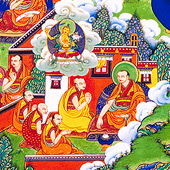 Tsongkhapa began to focus on studying Tantra when he was 34 years old. At this time, he met a Karma Kagyu Lama called Umapa who had come to him to get authorization of Saraswati. During their discussion, Lama Umapa told Tsongkhapa that he had a vision of Manjushri in which Manjushri had asked him to see Tsongkhapa for Saraswati’s empowerment initiation. Lama Umapa explained that he had experienced regular visions of Manjushri since his childhood but he was unsure if it was really Manjushri. He requested Tsongkhapa to investigate. Tsongkhapa thus examined thoroughly and concluded that Lama Umapa and Manjushri were of the same mind. Checking the authenticity of visions is critical as visions can be misrepresented by demons. Demons can appear as holy beings to manipulate us, therefore out of humility, even highly attained monks would usually ask another qualified being to check the authenticity of a vision.
Tsongkhapa began to focus on studying Tantra when he was 34 years old. At this time, he met a Karma Kagyu Lama called Umapa who had come to him to get authorization of Saraswati. During their discussion, Lama Umapa told Tsongkhapa that he had a vision of Manjushri in which Manjushri had asked him to see Tsongkhapa for Saraswati’s empowerment initiation. Lama Umapa explained that he had experienced regular visions of Manjushri since his childhood but he was unsure if it was really Manjushri. He requested Tsongkhapa to investigate. Tsongkhapa thus examined thoroughly and concluded that Lama Umapa and Manjushri were of the same mind. Checking the authenticity of visions is critical as visions can be misrepresented by demons. Demons can appear as holy beings to manipulate us, therefore out of humility, even highly attained monks would usually ask another qualified being to check the authenticity of a vision.
Tsongkhapa greatly wished to learn the practices of Manjushri and requested Lama Umapa to be his teacher. Through the mediation of Lama Umapa, Tsongkhapa began to receive teachings from Manjushri. Tsongkhapa would ask Manjushri questions through Lama Umapa who would relay the answers from Manjushri himself.
In 1392, Tsongkhapa went to Lhasa with Umapa and made abundant offerings to the famed Jowo Rinpoche statue in Jokhang Monastery. During a very intensive Manjushri retreat there, he gained a very clear vision where Manjushri appeared within a mandala. On Manjushri’s chest was written a red mantra. However, out of deep humility, he did not speak about his visions until his Lama Umapa asked him about them.
Purification Retreats
It was while Lama Tsongkhapa was engaging in many meditations, Manjushri appeared and spoke to Lama Umapa, advising him to tell Tsongkhapa that he was doing too much meditation. Manjushri advised Lama Tsongkhapa that he would not gain realizations by meditation alone. This was because although meditation practice helps a practitioner to collect positive merits and purify negative karma, it would not purify all of Tsongkhapa’s negative karma at the rate that was necessary for him to become enlightened. Manjushri thus advised Tsongkhapa to see his Guru as being of the same nature as his Yidam,and to make requests and increase purification practices to clear the accumulated faults and mistakes he had previously committed. If Tsongkhapa was to give teachings at that time, the benefits would not be as significant as if he were to go into purification retreat.
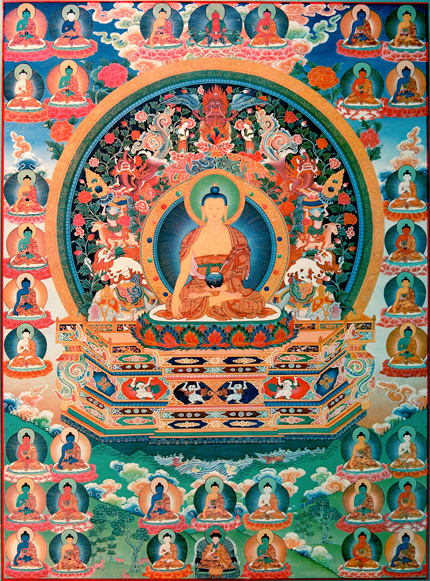
35 Confessional Buddhas
Therefore, at 36 years old, Lama Tsongkhapa went into a four-year retreat with eight disciples who had been selected by Manjushri; four were from the region of U, Pelden Sangpo, Tokden Djang-sen, Neten Rinchin Gyeltsen and Neten Sangkyong. The other four were from Amdo, who were Lama Tokden Jampel Gyatso, Geshe Sherap Drak, Geshe Djam-pel Trashi and Geshe Pel-kyong.
The site of their retreat was a cave called Wolka Cholung, which remains a highly revered pilgrimage site today. There, he and his eight disciples engaged in a four-year retreat, which became among his most famous retreats. Within the four years, he performed 100,000 prostrations to each of the 35 Confessional Buddhas, completing a total of 3.5 million prostrations. Normally, practitioners would only perform 100,000 prostrations to all of the 35 Confessional Buddhas at once; this would take approximately six to seven months. Lama Tsongkhapa took his practice much further by doing 100,000 not just to the collective 35 Buddhas, but to each individual Buddha to purify his negative karma. Imprints of his body could be seen onto the ground after the retreat. Because of this ardent practice, he gained direct visions of the 35 Confessional Buddhas.
At the conclusion of the retreat, Lama Tsongkhapa had a vision of Manjushri directly whereupon Manjushri told him that his negative karma was purified. Manjushri told Tsongkhapa, “Your last obscurations are purified. You can see me now. You do not need to go through Lama Umapa anymore. “However, Lama Tsongkhapa was so humble, he refused to believe that the vision he saw was really of Manjushri until his Guru, Lama Umapa, confirmed that his vision was true. Tsongkhapa also gained a vision of Maitreya Buddha at the end of this retreat.
During that famous retreat, Tsongkhapa also did 1.8 million mandala offerings with his hands, and as the base of his mandala was made of rocks, his wrists and forearms became raw and bleeding. Many masters now cite this retreat as an example of how much dedication Tsongkhapa put towards his practice, although he was already so highly attained. It is a reminder to all spiritual practitioners of the faith and commitment that we should invest in our spiritual path.
The Lamrim Chenmo
In the early 15th Century, many scholars and lamas began requesting Lama Tsongkhapa to write books that would provide teachings about the graded path to Enlightenment. Thus, Tsongkhapa began to write the Lamrim Chenmo, or The Graded Stages of the Path to Enlightenment.
Among the many texts he composed, the Lamrim Chenmo is Tsongkhapa’s most famous work. This important treatise is based on Atisha’s text, Lamp for the Path to Enlightenment. Tsongkhapa’s Lamrim Chenmo united all Buddha’s teachings of the existing schools of Buddhism in Tibet and even of the Indian pandits, and provides a most excellent guideline for the practice of Dharma, from the moment we step onto the path all the way up to Enlightenment.
After completing the Lamrim Chenmo, Tsongkhapa then began writing the Ngarim Chenmo, or The Stages of the Path of Tantra. Among his other famous texts, Tsongkhapa also wrote many extensive commentaries on root texts such as the 50 Stanzas on Guru Devotion and the 14 Tantric vows.
Reviving Monastic Discipline
During the period of decline, monastic communities had not followed the rules of the Vinaya (monastic rules) conscientiously, Buddhist practices had degenerated, the Sangha had become corrupt and were abandoning themselves to worldy pleasure.
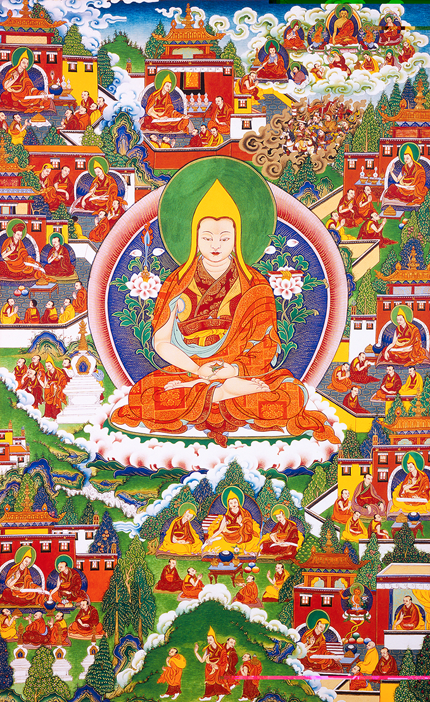
However, Tsongkhapa followed the methods of Atisha – the prominent Indian Buddhist said of the 11th Century – to revive monastic disciple. In his teachings, he particularly stressed the importance of holding vows and commitments, and adhering to discipline. Not only did he teach, he embodied the teachings and maintained excellent discipline himself.
With the guidance of his Gurus, Rendawa and Chennga Chkoyki Gyalpo, and his personal example, Tsongkhapa accomplished the enormous task of reviving the Vinaya among the Sangha. For this, he gained great respect from many people who began to follow his teachings and become his disciples. Tsongkhapa explained that the reason why he had emphasized so strongly on monastic discipline was because he did not wish for Buddha’s doctrine to degenerate again in Tibet.
…without practising
The three ethics, Enlightenment cannot be attained.
Knowing this well, please bless me to intensively
strive to train in the Bodhisatta vows.
-Yonten Shigyurma
The Great Monasteries
Maitreya Statue at Dzingji
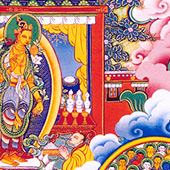 Throughout his life, Lama Tsongkhapa made extensive offerings to the Three Jewels. The first of his Great Deeds was the restoration of the ruins of the Maitreya Statue in Dzingji Temple to a resplendent state. As advised by Manjushri, Tsongkhapa went to the temple and wept when he saw the dilapidated state of the buildings and the statue within. The Maitreya statue was covered in dust and dirt and Tsongkhapa resolved to restore it. However, just when construction was about to begin, Lama Tsongkhapa found that he did not have enough funds for the restoration. Tsongkhapa and his disciples then decided to make offerings and request for assistance from Vaishravana, the Protector of Wealth. As a result, resources arose and Tsongkhapa was able to carry out his task. There were many instance when Tsongkhapa requested assistance from Vaishravana with offerings and because of Tsongkhapa’s pure motivation for the Dharma, whatever Tsongkhapa needed would manifest. Many miracles happened during the renovation of this temple. When a painting of Manjushri was outlined on the wall and Tsongkhapa carried out a consecration ritual on the image, Manjushri appeared as a Wisdom Being and dissolved into the painting. This happened with all the paintings of Wisdom Beings in the temple.
Throughout his life, Lama Tsongkhapa made extensive offerings to the Three Jewels. The first of his Great Deeds was the restoration of the ruins of the Maitreya Statue in Dzingji Temple to a resplendent state. As advised by Manjushri, Tsongkhapa went to the temple and wept when he saw the dilapidated state of the buildings and the statue within. The Maitreya statue was covered in dust and dirt and Tsongkhapa resolved to restore it. However, just when construction was about to begin, Lama Tsongkhapa found that he did not have enough funds for the restoration. Tsongkhapa and his disciples then decided to make offerings and request for assistance from Vaishravana, the Protector of Wealth. As a result, resources arose and Tsongkhapa was able to carry out his task. There were many instance when Tsongkhapa requested assistance from Vaishravana with offerings and because of Tsongkhapa’s pure motivation for the Dharma, whatever Tsongkhapa needed would manifest. Many miracles happened during the renovation of this temple. When a painting of Manjushri was outlined on the wall and Tsongkhapa carried out a consecration ritual on the image, Manjushri appeared as a Wisdom Being and dissolved into the painting. This happened with all the paintings of Wisdom Beings in the temple.
Gaden Monastery
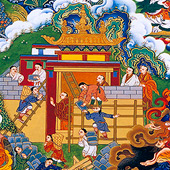 As Lama Tsongkhapa’s renown grew and grew, his disciples requested him to establish a monastery. Many patrons and high lamas offered him their own monasteries and rich sponsors offered to finance the construction of a new monastery, Tsongkhapa requested guidance from the statue of Jowo Rinpoche at the Jokhang and from visions and dreams he had, Tsongkhapa decided to build Gaden monastery in 1409 at the Drok Riwo mountains. This would become the first and most central monastic institution of the Gelugpa school of Buddhism, which was also established by Tsongkhapa. Lama Tsongkhapa’s two disciples, Gyaltsab Je and Bhikkshu Gyeltsen (1375-1434) were in charge of the construction of Gaden monastery. The buildings were designed and constructed according to the Vinaya rules, such as the size of the rooms which are stipulated within the Vinaya texts. This was yet another example of how Tsongkhapa embodied the Buddhist doctrine in very part of his life.
As Lama Tsongkhapa’s renown grew and grew, his disciples requested him to establish a monastery. Many patrons and high lamas offered him their own monasteries and rich sponsors offered to finance the construction of a new monastery, Tsongkhapa requested guidance from the statue of Jowo Rinpoche at the Jokhang and from visions and dreams he had, Tsongkhapa decided to build Gaden monastery in 1409 at the Drok Riwo mountains. This would become the first and most central monastic institution of the Gelugpa school of Buddhism, which was also established by Tsongkhapa. Lama Tsongkhapa’s two disciples, Gyaltsab Je and Bhikkshu Gyeltsen (1375-1434) were in charge of the construction of Gaden monastery. The buildings were designed and constructed according to the Vinaya rules, such as the size of the rooms which are stipulated within the Vinaya texts. This was yet another example of how Tsongkhapa embodied the Buddhist doctrine in very part of his life.
Drepung Monastery
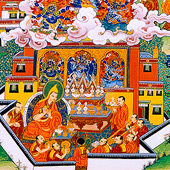 Following the construction of Gaden, Tsongkhapa told one of his students, Trashi Pelden Pelsangpo, also known as Jamyang Choje (1379-1449), that if he built a monastery, it would be even bigger than Gaden. He offered the conch shell which was uncovered during the construction of Gaden to Jamyang Choje, who proceeded to build Drepung, another of the greatest Gelugpa monasteries. The conch shell remained at Drepung until the mid 20th century. Construction began in 1416 and was completed in 1419. In his last few months, Tsongkhapa went to Drepung to give teachings, during which a rainbow appeared and an earthquake shook the lands. People felt that this was a sign that Tsongkhapa would be leaving. While he was teaching the Guhyasamaja Tantra, Rinpoche stopped teachings halfway and despite many entreaties by his disciples to complete the teachings, Tsongkhapa left. As he departed, there was a sudden earthquake and the sky became very dark; many rainbows and clear streams of light shone forth in the direction of Gaden. By Tsongkhapa leaving some teachings still be taught, he left an auspicious omen for his teachings to endure.
Following the construction of Gaden, Tsongkhapa told one of his students, Trashi Pelden Pelsangpo, also known as Jamyang Choje (1379-1449), that if he built a monastery, it would be even bigger than Gaden. He offered the conch shell which was uncovered during the construction of Gaden to Jamyang Choje, who proceeded to build Drepung, another of the greatest Gelugpa monasteries. The conch shell remained at Drepung until the mid 20th century. Construction began in 1416 and was completed in 1419. In his last few months, Tsongkhapa went to Drepung to give teachings, during which a rainbow appeared and an earthquake shook the lands. People felt that this was a sign that Tsongkhapa would be leaving. While he was teaching the Guhyasamaja Tantra, Rinpoche stopped teachings halfway and despite many entreaties by his disciples to complete the teachings, Tsongkhapa left. As he departed, there was a sudden earthquake and the sky became very dark; many rainbows and clear streams of light shone forth in the direction of Gaden. By Tsongkhapa leaving some teachings still be taught, he left an auspicious omen for his teachings to endure.
Sera Monastery
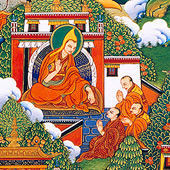 In 1419, another Tsongkhapa’s disciples, Shakya Yeshe, built Sera monastery as a place dedicated to tantric teachings. Shakya Yeshe raised the necessary resources to build the monastery and supervised the its construction to ensure its accordance with the Vinaya. Together, Gaden, Drepung and Sera would become three of Tibet’s most prominent monastic institutions and housed several thousand monks. Today, these three monasteries have been re-established in india, where they continue to flourish with a rich Sangha community and produced unrivalled, highly skilful and wise Dharma teachers.
In 1419, another Tsongkhapa’s disciples, Shakya Yeshe, built Sera monastery as a place dedicated to tantric teachings. Shakya Yeshe raised the necessary resources to build the monastery and supervised the its construction to ensure its accordance with the Vinaya. Together, Gaden, Drepung and Sera would become three of Tibet’s most prominent monastic institutions and housed several thousand monks. Today, these three monasteries have been re-established in india, where they continue to flourish with a rich Sangha community and produced unrivalled, highly skilful and wise Dharma teachers.
Back to the Pure Land
On Lama Tsongkhapa’s way back from Drepung, he visited Jokhang monastery to make many offerings and prostrations to Jowo Rinpoche. He prayed there that Dharma would exist forever. Many people thought this unusual – it is only when he was very sure that he would not be coming back to a place that Tsongkhapa would do prostrations as he left.
When Tsongkhapa returned to Gaden, he made many offerings, dedicated the merit to all sentient beings and recited a Pure Land prayer. That night, he felt great pain all over his body and the monks performed prayers for him.
On the second day, he passed his pandit’s hat to one of his foremost disciples Gyaltsab Je, requesting him to inherit the teaching throne.
On the morning of October 25, Tsongkhapa entered into samadhi meditation. He made many inner offerings and stopped his breath. Many saw his body transform back into that of a 16-year-old boy and rainbows emitting from his body. Some even saw dakas and dakinis in the sky, making a lot of offerings to welcome Tsongkhapa back into the Pure Land. He was 63 when he passed away.
Gyaltsab Je inherited Tsongkhapa’s throne, becoming the first Gaden Tripa (Gaden Throne Holder) to continue Tsongkhapa’s magnificent lineage. This is symbolic of Tsongkhapa’s presence on earth and the propagating of his teachings. The illustrious position of the Gaden Tripas continues in an unbroken lineage until today, upholding Tsongkhapa’s teachings with great fortitude and practice.
Lama Tsongkhapa’s Two Heart Sons
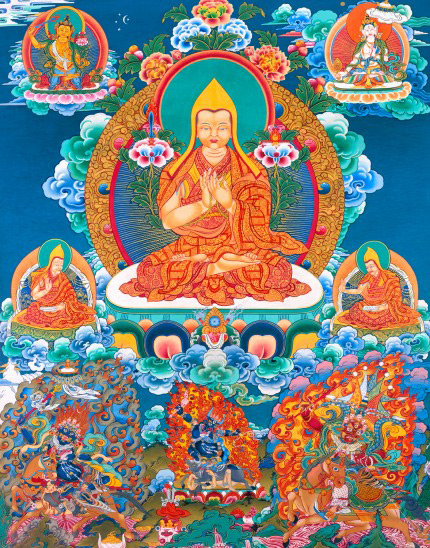
Lama Tsongkhapa and his two Heart Sons.
Gyaltsab Je
Gyaltseb Je (1364-1432), also known as Dharma Rinchen, was an ordained monk of the Sakya lineage who was an accomplished and eloquent scholar, famed for his intellect and knowledge. He had heard of Lama Tsongkhapa’s renown but thought that his own knowledge was superior to Tsongkhapa. Supremely confident, he went to attend a teaching by Tsongkhapa at Ratrong Monastery. When he arrived, Tsongkhapa had already started teaching. Unabashed, Gyaltsab Je walked in proudly, not even removing his hat. which he should have done as a sign of respect. He even climbed up to sit on the same throne from which Tsongkhapa was giving his teaching. Tsongkhapa was not at all perturbed, and simply moved aside to give Gyaltsab Je some space on the throne.
However, as Gyaltsab Je listened to the incomparable Tsongkhapa, he was stunned by the profundity of the teachings. Immediately, he realized the error of his arrogance and removed his hat. He quickly climbed down from the throne, made three prostrations to Tsongkhapa and sat down on the floor with the other disciples. From then on, Gyaltsab Je was completely devoted to Tsongkhapa and became one of his main disciples who supervised the construction of Gaden Monastery.
Before Tsongkhapa passed into clear light, he appointed Gyaltsab Je as the second Abbot of Gaden Monastery, Tsongkhapa himself being the first Abbot, as well as the first throneholder of the Gaden tradition.
Khedrup Je
Khedrup Je (1385-1438) also known as Gelek Pelsang, was extremely accomplished in his learning and well respected for his knowledge. At the age of 16, he went to the region of Tsang to participate in the dialectical debates. There, the master Tchok-le Namgyel was challenging all the monks to a debate but no one dared accept.
Unafraid and confident despite his youth, Khedrup Je stepped up and successfully rebutted all of Tchok-le Namgyel’s positions. The points Khedrup Je brought up during his debate was noted by the scholars in attendance and later incorporated in his composition on The Seven Treatises on Valid Cognition.
Khedrup Je was ordained in the Sakya tradition by the great Master Rendawa, who advised him to meet with Tsongkhapa. When Khedrup Je met with Tsongkhapa, Tsongkhapa predicted that Khedrup Je would have great tantric achievements and benefit many. Khedrup Je became extremely devoted to Tsongkhapa and wrote Tsongkhapa’s biography after the great master passed into clear light. As the other heart son of Tsongkhapa, he became the third Abbot of Gaden and the second Gaden Tripa after Gyaltsab Je.
After Lama Tsongkhapa passed away, Khedrup Je always used to pray to him. He always thought about his Guru and was always sad. When Khedrup Je had some questions about Dharma, he could not ask any scholars because he was the best scholar in the land at the time. So, one day, he made a mandala offering to Lama Tsongkhapa and strongly request Tsongkhapa to come. The minute he made this offering, Lama Tsongkhapa appeared from the Gaden Heaven, from the heart of Maitreya and answered his questions. When Khedrup Je understood and all was clear, Lama Tsongkhapa dissolved back into Gaden Heaven. Lama Tsongkhapa appeared five times to Khedrup Je, which is now known as the five visions of Tsongkhapa.
The Five visions of Tsongkhapa
1. On an elephant
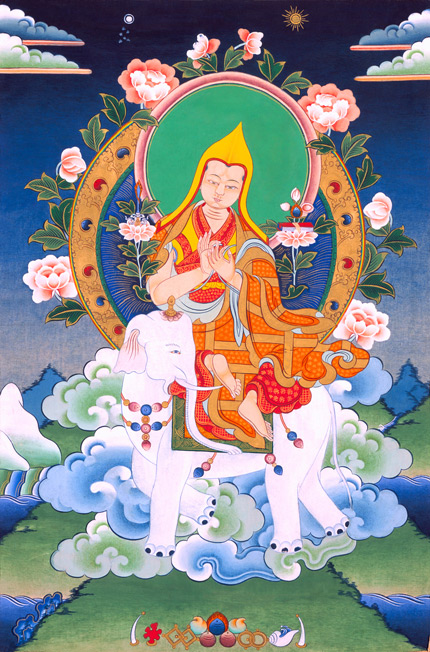
Tsongkhapa was seated on a jewelled seat, upon a white elephant with six tusks. Tsongkhapa spoke to Khedrup Je and advised him to not be consumed by sadness and that if he thinks of his Guru, he could purify the negative actions he had previously committed and accumulate much merits. Tsongkhapa also advised him to read the mystical songs by Milarepa and to work on developing the teachings.
2. On a Throne held by celestial beings
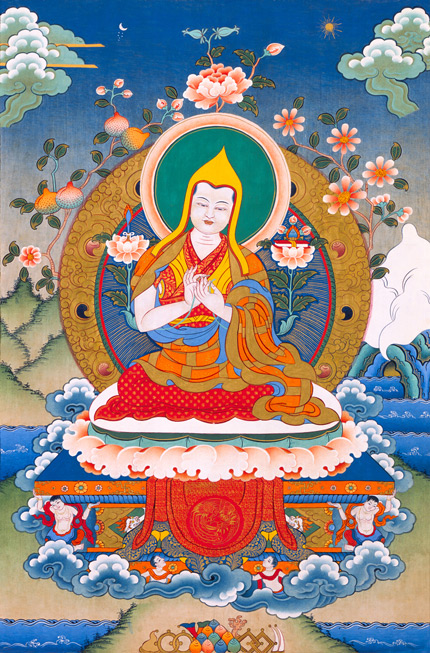
At another time, upon the request of Khedrup Je, Tsongkhapa appeared again, this time on a throne of gold and jewels, held by many youthful celestial beings. Tsongkhapa gave Khedrup Je teachings to clarify his questions and deepened his understanding of the doctrine.
3. As Manjushri on a white Lion
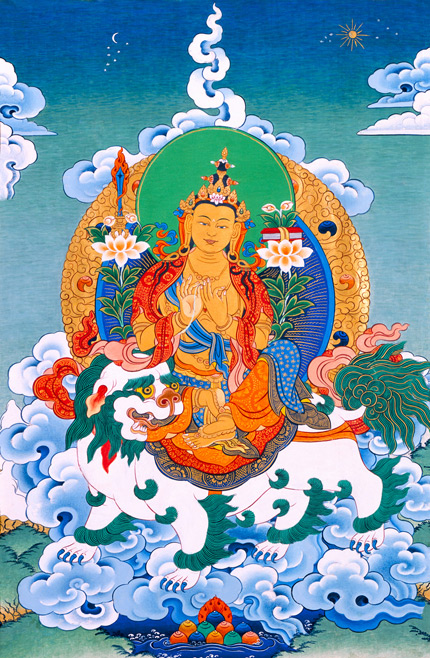
The next time Khedrup Je invoked his Guru, Tsongkhapa appeared – this time in the form of a 16 year old, Bodhisattva Manjushri, with a red-orange body, sitting upon a bejewelled white lion. In this form, Tsongkhapa advised Khedrup Je to spread the tantric teachings.
4. As a Yogi on a Tiger
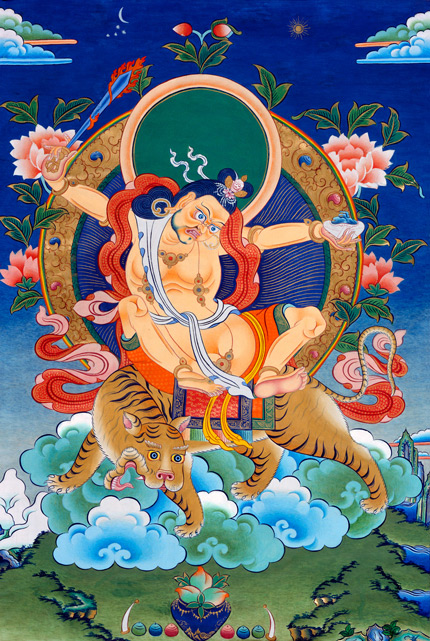
In Khedrup Je’s fourth vision of his Guru, Tsongkhapa appeared in the form of a yogi with long red hair tied with green silk at the top of his head. He was riding a ferocious tiger and his right hand carried a flaming sword like Manjushri while his left held a skull cup of nectar at his heart. Tsongkhapa advised him that whenever he thought of his Guru, he should read the treatises Tsongkhapa composed on the two stages of generation and completion of the path of the Tantras.
5. In his normal form
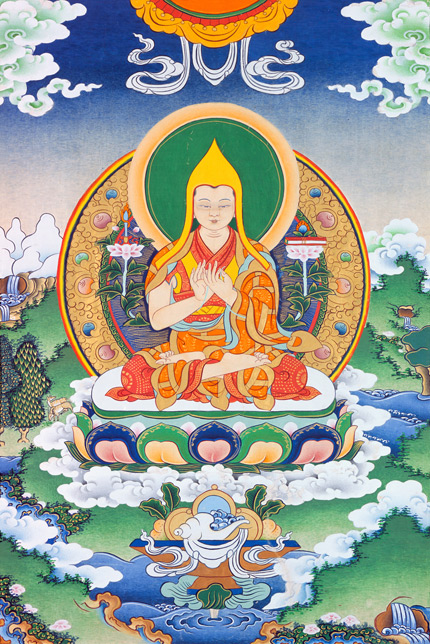
The final time that Tsongkhapa appeared to Khedrup Je in a vision, he was in the form of an ordained monk, in the middle of a white cloud. Tsongkhapa told Khedrup Je that he was giving a teaching on Wu Tai Mountain in China to an assembly of more than 1800 holders of the vajra. He advised Khedrup Je to make prayers to go there too and that they would meet again soon.
On Lama Tsongkhapa’s last appearance to him, Khedrup Je cried and cried and asked his Guru, “Please may I not stay on Earth anymore. May I join you in Gaden Heaven, please?”
Khedrup Je had already asked Lama Tsongkhapa this many times previously and each time, Lama Tsongkhapa had told him not to come yet.
However, on that last occasion, Lama Tsongkhapa said to him, “Yes, you may come.”
Khedrup Je went into meditation, passed into clear light and was born in Gaden Heaven with his Guru, Lama Tsongkhapa. These disciples were not just ordinary disciples but enlightened Beings themselves.
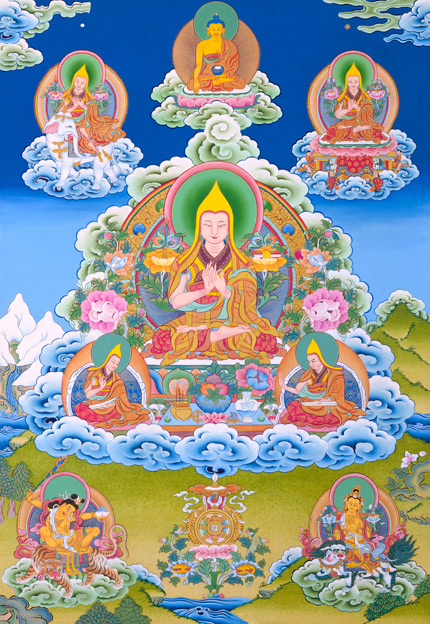
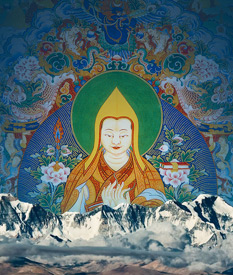

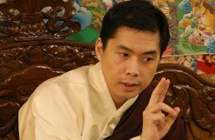
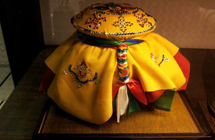
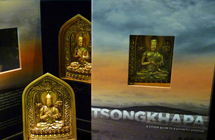
SOCIAL MEDIA
TweetRECENT ARTICLE POSTS
A Tsongkhapa Meditation
Blog Chat Quiz / Debate - { PART FOUR }
Blog Chat Quiz / Debate - { PART THREE }
Blog Chat Quiz / Debate - { PART TWO }
Blog Chat Quiz / Debate - { PART ONE }
Lama Tsongkhapa Quiz Challenge
A Song Rapidly Invoking Blessings
Amazing Ganden Khenpa
TWEETS ABOUT #TSONGKHAPA
TOTAL VISITS